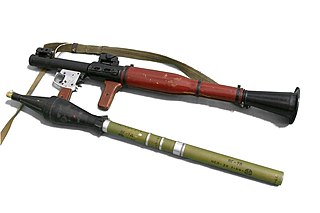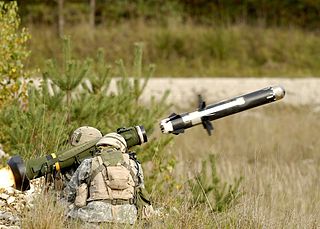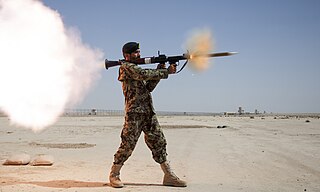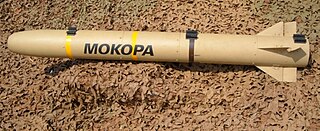
A missile is an airborne ranged weapon capable of self-propelled flight aided usually by a propellant, jet engine or rocket motor.

A rocket-propelled grenade (RPG) is a shoulder-fired rocket weapon that launches rockets equipped with an explosive warhead. Most RPGs can be carried by an individual soldier, and are frequently used as anti-tank weapons. These warheads are affixed to a rocket motor which propels the RPG towards the target and they are stabilized in flight with fins. Some types of RPG are reloadable with new rocket-propelled grenades, while others are single-use. RPGs are generally loaded from the front.

An anti-tank guided missile (ATGM), anti-tank missile, anti-tank guided weapon (ATGW) or anti-armor guided weapon is a guided missile primarily designed to hit and destroy heavily armored military vehicles. ATGMs range in size from shoulder-launched weapons, which can be transported by a single soldier, to larger tripod-mounted weapons, which require a squad or team to transport and fire, to vehicle and aircraft mounted missile systems.

The AGM-114 Hellfire is an American air-to-surface missile (ASM) first developed for anti-armor use, later developed for precision drone strikes against other target types, especially high-value targets. It was originally developed under the name "Heliborne laser, fire-and-forget missile", which led to the colloquial name "Hellfire" ultimately becoming the missile's formal name. It has a multi-mission, multi-target precision-strike ability and can be launched from multiple air, sea, and ground platforms, including the MQ-1 Predator and MQ-9 Reaper. The Hellfire missile is the primary 100-pound (45 kg) class air-to-ground precision weapon for the armed forces of the United States and many other nations. It has also been fielded on surface platforms in the surface-to-surface and surface-to-air roles.

Shoulder-fired missile, shoulder-launched missile or man-portable missile, among other variants, are common slang-terms to describe high-caliber shoulder-mounted weapons systems – that is: weapons firing large heavy projectiles ("missiles"), typically using the backblast principle, which are small enough to be carried by a single person and fired while held on one's shoulder. The word "missile" in this context is used in its original broad sense of a heavy projectile, and encompasses all shells and rockets, guided or unguided. A more formal variant is simply shoulder-fired weapons system and the like.

The ZT-6 Mokopa is a South African air-to-ground anti-tank guided missile. As of 2005, it is in its final stages of development, and is being integrated onto the South African Air Force's Rooivalk attack helicopters. The missile is produced by Denel Dynamics, formerly Kentron. The current version uses semi-active laser (SAL) guidance, requiring the target to be illuminated by a laser designator either on the launch platform or elsewhere; though there are alternative guidance packages available including a millimetre-wave radar (MMW) seeker and a two-colour imaging infrared (IIR) seeker.

The HJ-8 or Hongjian-8 is a second generation tube-launched, optically tracked, wire-guided anti-tank missile system which was originally deployed by the People's Liberation Army since the late 1980s.

The 9K121 Vikhr is a Soviet laser-beam-riding anti-tank missile. "9K121" is the GRAU designation for the missile system. The missile can be launched from warships, Ka-50 and Ka-52 helicopters, and Su-25T aircraft. It was first shown publicly at the 1992 Farnborough Airshow.

The ZT3 Ingwe (Leopard) is a modern South African multi-role laser beam riding anti-tank guided missile (ATGM) manufactured by Denel Dynamics.

Spike is an Israeli fire-and-forget anti-tank guided missile and anti-personnel missile with a tandem-charge high-explosive anti-tank (HEAT) warhead. As of 2007, it is in its fourth generation. It was developed and designed by the Israeli company Rafael Advanced Defense Systems. It is available in man-portable, vehicle-launched, helicopter-launched and maritime variants.

The Nimrod is a long-range air-to-surface missile developed by Israel Aerospace Industries. While designed for mainly anti-tank warfare, it provides standoff strike ability against a variety of point targets such as armoured personnel carriers (APCs), ships, bunkers, personnel concentrations, and guerrillas.

UMTAS or Mizrak-U(Uzun Menzilli Tanksavar Sistemi) is a modern long range air-to-surface anti-tank guided missile developed by Turkish armor and missile manufacturer Roketsan.
The 2T Stalker, also known as BM-2T Stalker, is a Belarusian armoured vehicle. it is a part of the GM chassis and It never entered production.

A precision-guided munition is a guided munition intended to hit a specific target, to minimize collateral damage and increase lethality against intended targets. During the First Gulf War guided munitions accounted for only 9% of weapons fired, but accounted for 75% of all successful hits. Despite guided weapons generally being used on more difficult targets, they were still 35 times more likely to destroy their targets per weapon dropped.

The Hongjian-12 is a third generation, man-portable, fire-and-forget infrared homing anti-tank missile of China. It was unveiled at the Eurosatory 2014 exhibition.
The Pike is a precision-guided mini-missile or grenade munition designed by Raytheon. It is a 40 mm guided munition that can be fired from the barrel of a Heckler & Koch M320 Grenade Launcher Module and Enhanced Grenade Launching Module (EGLM) like a standard 40mm grenade, but is powered by a rocket motor to propel it 2,000 m to give infantrymen improved extended-range precision capabilities. The weapon uses a digital, semi-active laser seeker to guide itself to within five meters of the target; it can operate in a two-man shooter/spotter team or by the grenadier alone lazing after firing, as it can fly for 15 seconds before homing in. When fired, Pike has a small propellant to "kick" it 2.5–3 m (8.2–9.8 ft) out of the tube before the nearly smokeless motor ignites, and range is dependent on firing angle. The munition is effective against fixed and slow-moving mid-range targets, using a 6⁄10 lb blast fragmentation warhead with a 10-meter lethality radius. Raytheon developed the weapon for three years in collaboration with Nammo Talley, which developed the warhead and propulsion system. The Pike is intended to be more accurate with a longer range than rocket propelled grenades (RPGs) and standard rifle grenades, while being far lighter and more cost-effective than current infantry guided weapons like the $78,000 each FGM-148 Javelin. Further improvements could include different fuses, multiple-round simultaneous programming and targeting with data-link capabilities, and platform integration onto small boats, vehicles, and small unmanned aerial vehicles (UAVs). Pike weighs 1.7 lb (0.77 kg) and is 16.8 in (43 cm) long, too long to fit in the breech of the M203 grenade launcher. At AUSA 2015, Raytheon revealed they had performed two successful test firings of the Pike.

The 9M133M Kornet-M Russian anti-tank guided missile (ATGM) is an improved version of the 9M133 Kornet ATGM, with increased range and an improved warhead.

The KAI LAH is a compact twin-engine combat helicopter that is being developed by Korea Aerospace Industries (KAI).

The SAMHO is an Indian gun-launched anti-tank guided missile (ATGM) developed by the Armament Research and Development Establishment (ARDE) for the Arjun tanks of the Indian Army. Originally intended to be fired from the 120 mm rifled gun of Arjun, the DRDO plans to make it compatible with the T-90 tanks of the Indian Army, which have a 125 mm smoothbore gun. The SAMHO has a high-explosive anti-tank (HEAT) tandem-charge warhead designed to defeat explosive reactive armour (ERA) protection of modern armoured vehicles and tanks. The SAMHO is a multi-purpose anti-armour guided missile effective against tanks and low flying attack helicopters.


















